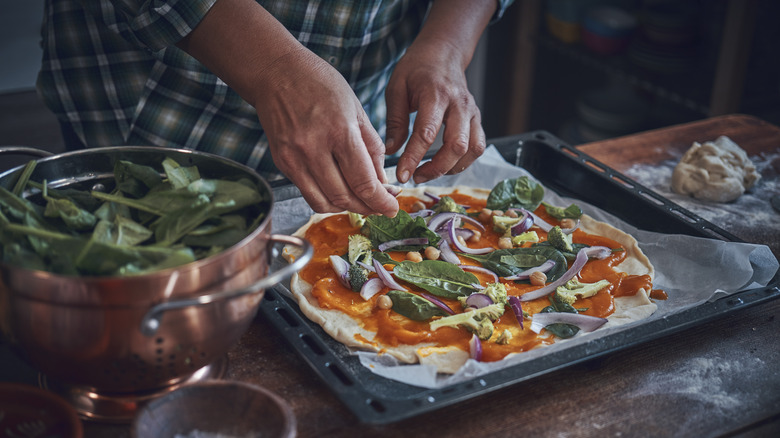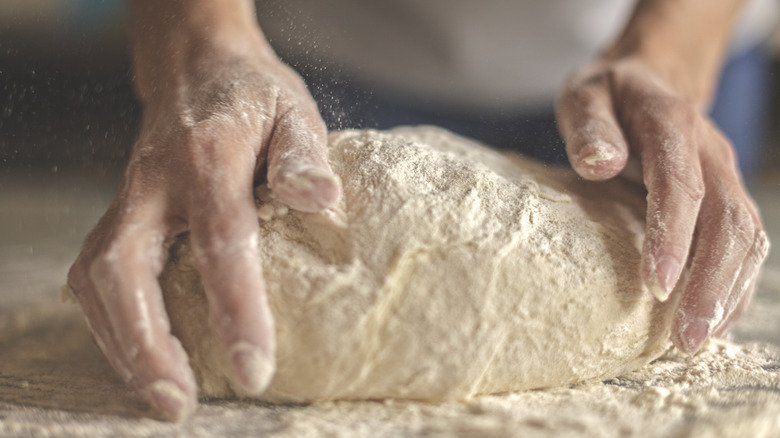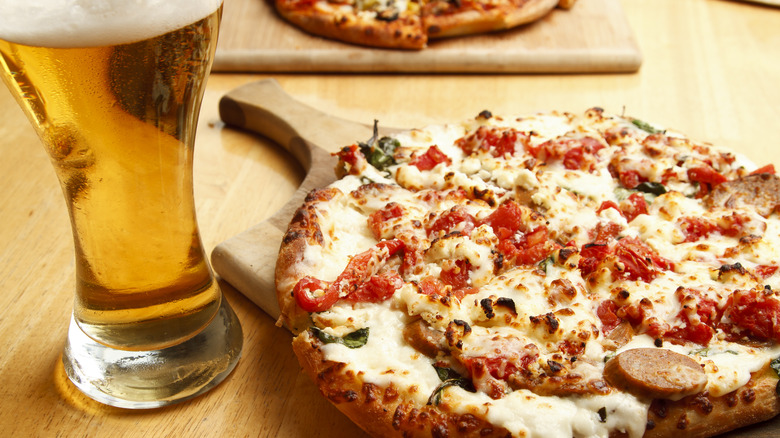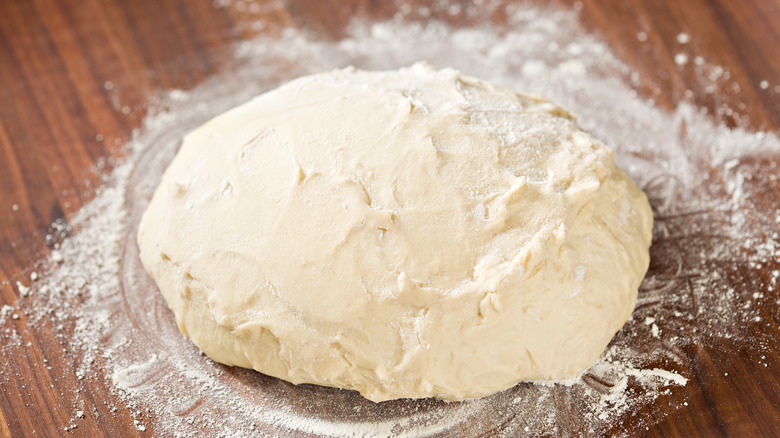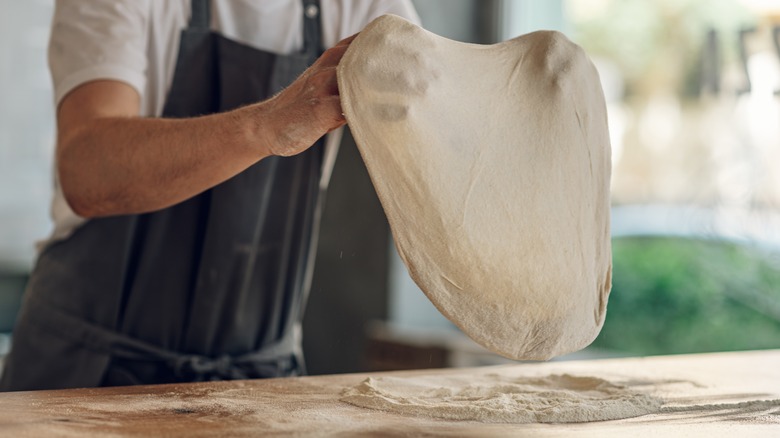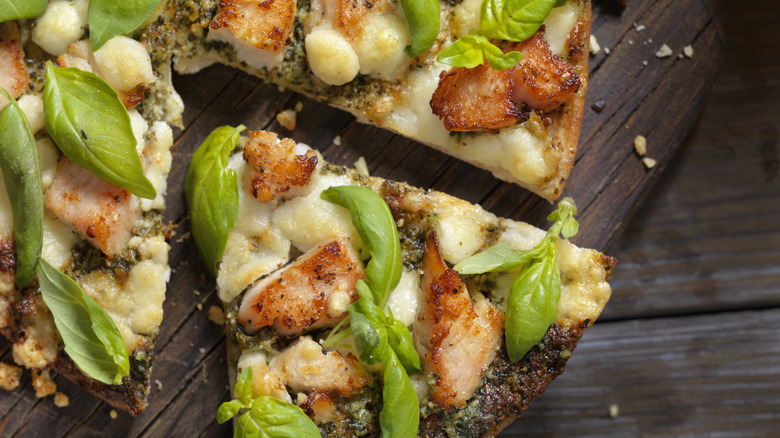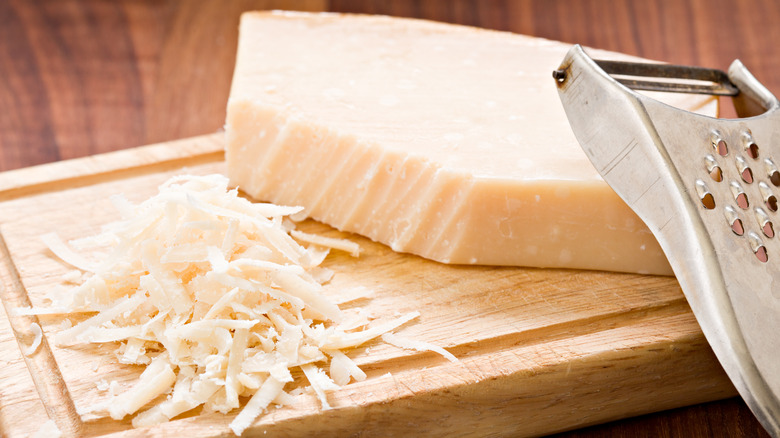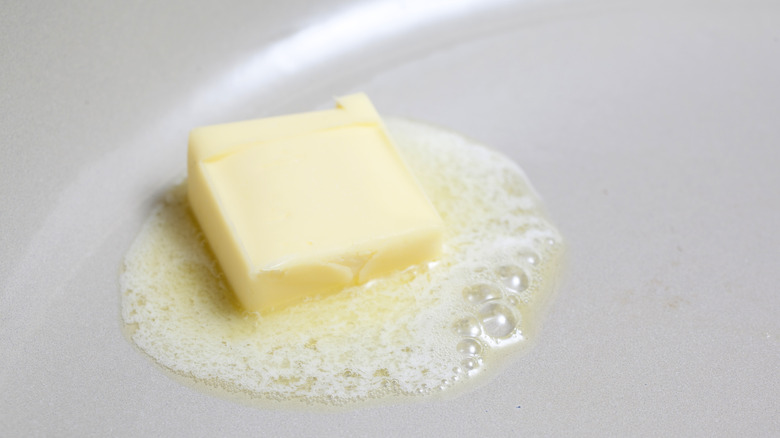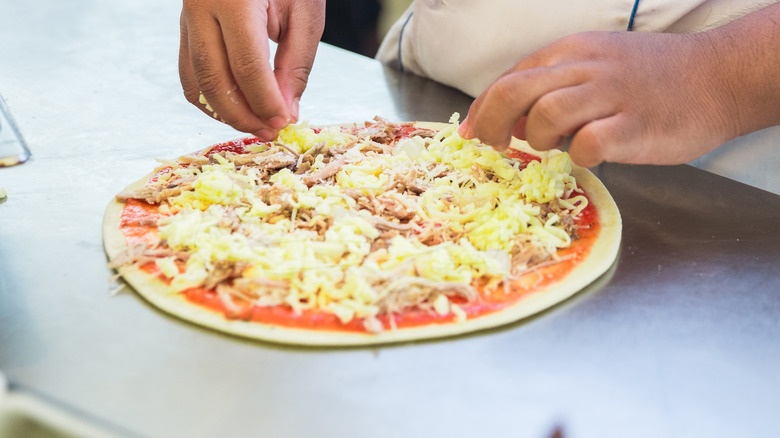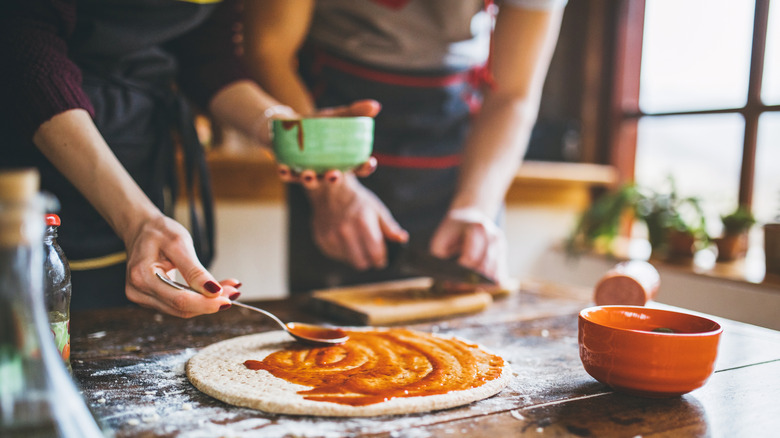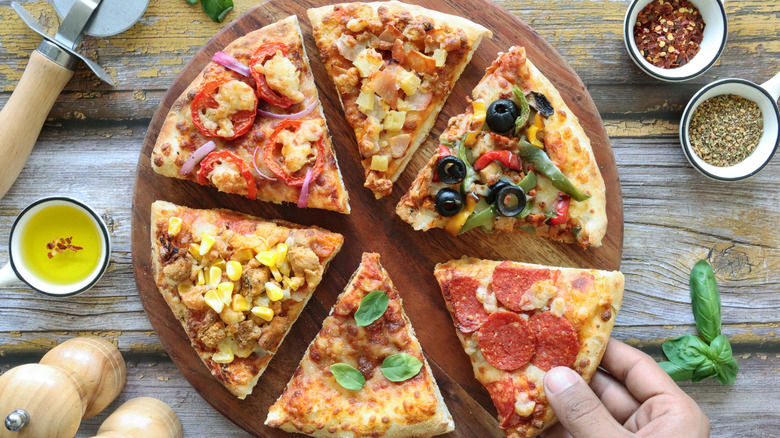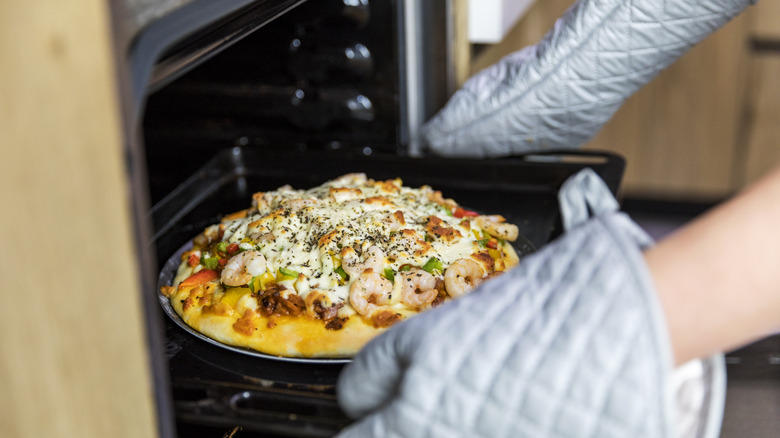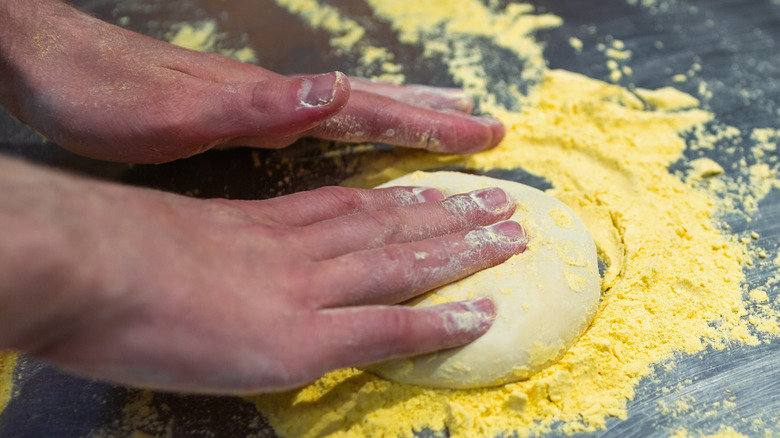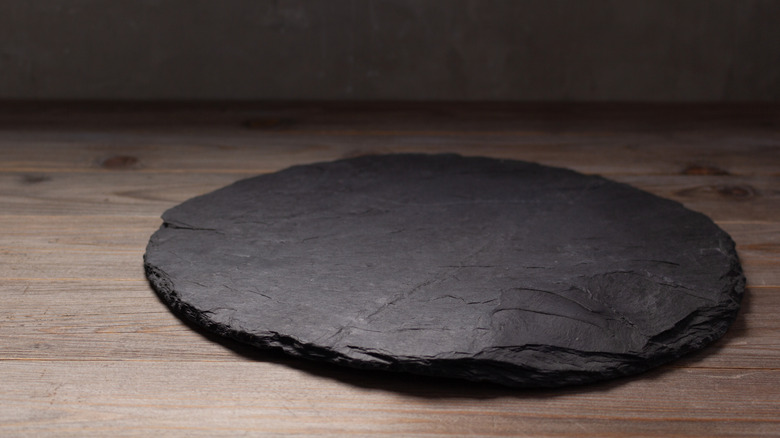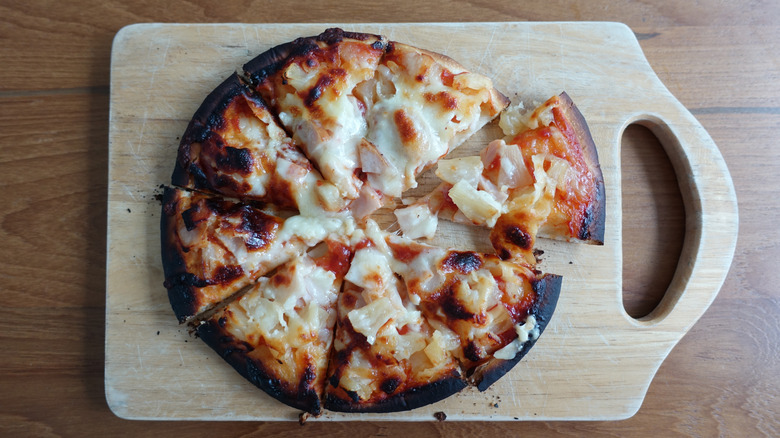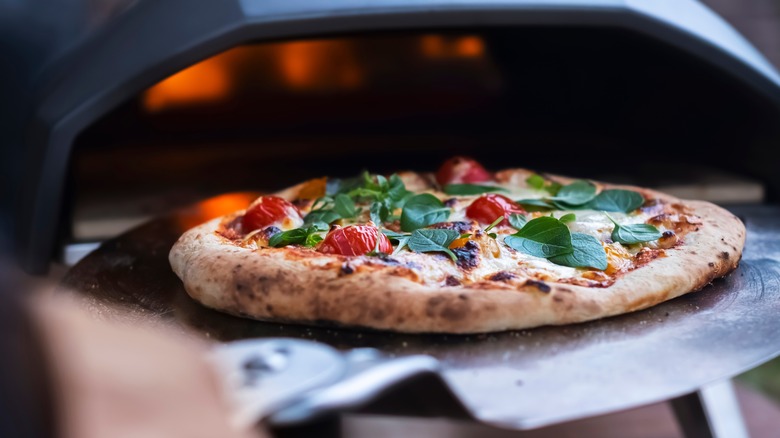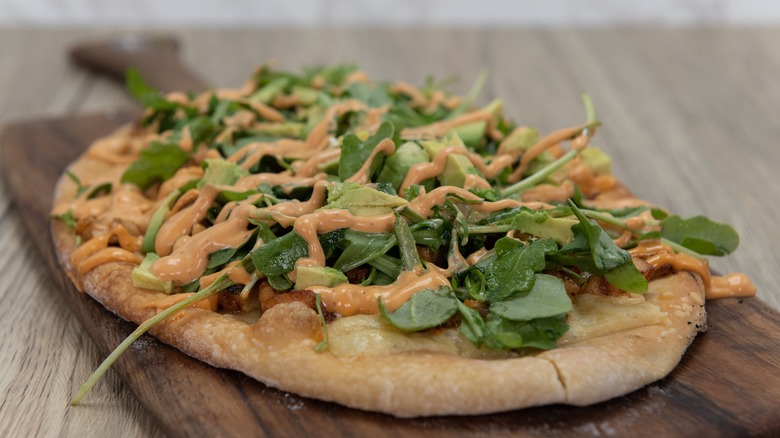17 Tips For Making The Best Homemade Pizza
Pizza nights are a staple in many households in America. One in eight Americans consumes pizza on any given day, per the United States Department of Agriculture, which amounts to about 13% of the population. And while buying these slices and pies from a local pizzeria or chain is an easy way to get your fair share of pepperoni and cheesy goodness, there's something much more satisfying about making your own at home. Not only do you get to design the perfect medley of toppings to add to your custom pie, but there's something humbling about watching all of your components come together in a single slice.
However, making pizza at home is a formidable task, especially for an inexperienced pizzaiolo (pizza maker). We've collected some of the most essential tips for creating a delicious pizza at home, from getting the crispiest, most flavorful crust to the most innovative sauces and toppings. Toss, sauce, and fire away!
1. Pay attention to the quantity, and quality, of your crust ingredients
The crust of your pizza is everything. It sets the tone of your dish — from flavor to texture. So, there's no reason why you wouldn't want to use the best-quality ingredients to make your homemade pizza truly spectacular.
Good crust starts in the flour. Most recipes use a blend of ultra-fine 00 pizza flour to give the dough a bit of elasticity. We love King Arthur 00 pizza flour blend — and the company even makes a gluten-free version too. Then, you'll also need to use active yeast for your recipe to ensure your dough rises properly; you can test your yeast by blooming it with water and a bit of sugar to see if it foams. You'll also need to get your hydration ratio just right when you're making homemade pizza crust. Start with a 65% hydration, meaning that for every 100 grams of flour, you use 65 grams of water. The dough should be tacky and sticky, and you may need to add more water or flour to reach this desired consistency.
2. Use beer to give your pizza crust volume
You usually eat pizza with beer, but you might be surprised by the results of adding beer to the pizza crust itself. It's the boozy ingredient that will change your pizza dough forever because it will not only impart a mild, hoppy flavor, but will also aid in the crust's ability to rise to the occasion.
You'll want to substitute your beer for the yeast in your recipe, as it will provide enough carbonation to give the dough its proper rise. The best kind of beer to use for your crust is a light beer, like a pilsner, because of its grainy smell and mild taste. If you use a beer that has more depth of flavor, you'll risk altering the fundamental flavor of your crust and the toppings you try to add. Pour in your room-temperature brew when you're mixing your dry ingredients — and don't forget to save a little for when the pie is out of the oven.
3. Do not rush the process of making pizza dough
Don't rush the process — it applies to pizza dough, too. Although you might be in a rush to get your pizza dough mixed, shaped, topped, and into the oven, you can't rush the resting process of the dough. Like all bread doughs, giving the crust an adequate amount of time for the dough to hydrate and the yeast to convert the sugars in the dough into carbon dioxide.
The best way to add more flavor to pizza crust is to let it do a cold ferment in the fridge for at least 24 hours before you plan on cooking with it. In addition, this process, albeit time-consuming, will improve the structure of the dough because fewer gas bubbles will escape as it ferments. This is especially true if you're working with a sourdough starter, which needs time for the culture to infuse flavor into the crust. However, you shouldn't let it ferment for more than 48 hours, as this will cause the yeast to form alcohol and produce an astringent taste.
If you're in a time crunch, you can buy pre-made pizza crust from a grocery store or make a two-ingredient pizza dough recipe with Greek yogurt and self-rising flour. There's no yeast involved, so the dough won't need nearly as much time to rise.
4. Gravity is your friend when stretching dough
If you've ever watched experience pizzaiolo flip, turn, and rotate pizza dough in the air, you might be a bit scared to try to take on this challenge in your home kitchen. Slinging dough isn't as easy as it looks, so we recommend taking the easy way out until you get more experience under your belt.
The key to stretching dough is letting gravity do the work for you. You can stretch the dough using your knuckles once you've stretched the dough into a disc on a floured surface. Pull the edges of the dough with your knuckles, and rotate the disc until the entire surface is stretched through. If you're making a Neapolitan pizza, you will want the dough to be as thin as possible — like a windowpane.
A rolling pin is the one tool you should never use to stretch your pizza dough. The real reason you shouldn't roll out pizza dough is that it will push out all the air bubbles in your dough and toughen up the gluten structure. This means your crust will be stodgy and hard rather than elastic and chewy.
5. Adventure beyond just tomato sauce
When you think of "pizza," you probably envision a crust covered in tomato sauce and sprinkled with copious amounts of cheese and pepperoni. But what if we told you there is a whole world out there that doesn't involve a lackluster tomato sauce?
Some of the delicious alternatives for classic pizza sauce include white sauces, green sauces, and everything in between. Our personal favorite is herby pesto. It's filled with bright, summery flavors that bring out the flavor of an artichoke or roasted red pepper topping. You can also hybridize your favorite Italian foods and add a schmear of alfredo sauce to your pie. Add bacon, spinach, and fresh basil chiffonade to balance out the color of your pizza.
If you're experimenting with more Americanized pizza toppings, try substituting your tomato sauce with a classic barbecue or buffalo sauce. Cheddar or mozzarella are perfect cheese blends to pair with these more unconventional toppings.
6. Utilize your sauce to build umami flavor
If you're just adding tomatoes, salt and pepper, and a splash of olive oil to your classic tomato pizza sauce, you're missing out on a ton of opportunities to add umami flavor to your pizza. Umami is a meaty, savory flavor that is present in ingredients like tomatoes, animal protein, and mushrooms. But you won't have to make a bolognese to take advantage of this flavor profile. You can add a splash of soy sauce, liquid aminos, or fish sauce to your sauce to amp up the umami flavor.
Parmesan cheese, for example, is an umami-rich ingredient that will change your homemade pizza sauce forever. Instead of grating a wedge of this salty cheese on the top of your pizza before popping it in the oven, grate it fresh right into the sauce as it's cooking. Besides adding a complex flavor element to your pizza, it also thickens it, which is critical to preventing soggy 'za.
7. Make your pizza sauce more decadent with butter
Olive oil and pizza go hand-in-hand, but butter is the ingredient you need to add a more unique flavor to your pizza instead. It's the rich addition that will take your pizza sauce to the next level. The creaminess and notes of the butter will round out the acidic tomatoes' sharpness and complement the olive oil's mouthfeel.
There are many different opportunities you have to add butter to your sauce. You can add a pat of it with olive oil when you're cooking down your herbs and aromatic ingredients like garlic. This will allow the herby notes to infuse into the fats and then into the tomatoes when those ingredients are mixed in. Alternatively, you can finish your sauce with a pat of butter; you may not even have to add as much sugar to the sauce.
8. Avoid sogginess by stacking your toppings correctly
One of the big mistakes people make with assembling their homemade pizza is just dumping the toppings on without any rhyme or reason. Instead, you need to consider the amount of time that each of your toppings needs to cook. The top layer of ingredients will always get the most amount of direct heat from the oven, so it's essential to avoid placing any components that will easily set aflame — like basil leaves and spinach — directly on top of the cheese. Instead, nestle these leafy greens below the cheese to protect them. Cooked toppings should be placed on after the cheese, followed by raw ingredients that need the most amount of cooking time. You should also think about chopping the ingredients into small, thin pieces to ensure that they all cook through.
You should precook sausage and other meats before adding them to your pizza. This will diminish the risk of contracting a foodborne illness since meat like bacon, sausage, and hamburger will need a longer cooking time than the pizza itself. Pre-packaged meat, like salami and prosciutto, is safe to eat without pre-cooking because it undergoes special food preservation processes that make it ready-to-eat out of the package.
9. Be conservative with your toppings
Making pizza is all about moderating moisture. If you add too many wet toppings, too much sauce, or all the above, you risk your pizza coming out of the oven raw rather than crispy. The key is to start with a thin layer of sauce (less than expected) pushed out toward the edge. Then, pair it with low-moisture cheese. While buffalo mozzarella is a flavorful, creamy option for cheeses, it tends to produce soggy pizza if used in excess. Therefore, use wet toppings and cheeses sparsely to avoid a sloppy pie.
If you're making thin pizza, try to limit yourself to three toppings, spread evenly so that you get a little bit in each bite. This includes moderating the amount of cheese you use on your pie. Believe us, it will melt down and spread out — you don't have to use an entire bag on your pie.
10. Ditch the pepperoni for something more gourmet
There are the pizza traditionalists, and then there's us. We're not saying the boring meat lover's pizza is lacking in the flavor department, but there are much better options out there for a flavorful pie. For example, the unexpected ingredient to add to your pizza this fall is mashed, roasted pumpkin. The sweetness of the squash unifies other toppings like crispy shallots, goat cheese, and thinly-sliced Granny Smith apples.
Our absolute favorite topping for a white pizza is leeks. This allium has the perfect amount of bite to it without being as overpowering as diced red onions. Pair this topping with bacon, chicken, and garlic. You can also substitute pineapple with a sweet winter fruit: kiwi. It's a transformative pizza topping because of its acidic and sugary undertone.
11. Cook your pizza at a high temperature, if you're opting for an oven
One of the reasons people often leave pizza-making to the pros is because of the high temperature needed to cook the crust perfectly. The biggest reason why your homemade pizza crust is too hard is because you're cooking your pie low and slow in your oven. This is just drying out the crust and rendering it too hard to enjoy.
The key to getting a high enough temperature in your oven is not just to jam the temperature knob up as high as it can go. Instead, it's a matter of using the bake and broil function. One way to try and replicate the cooking capacity of a brick oven is to preheat a steel baking pan or the bottom of the oven to 430 degrees Fahrenheit, baking the pizza for a little over a minute for the bottom crust to brown before transferring it to the broiler to finish cooking the toppings.
12. Use cornmeal to prevent the pizza from sticking
The thought of adding cornmeal to pizza is a divisive topic, to say the least. There are several reasons why adding cornmeal to the bottom of your pie is a good choice. It will make your homemade pizza way more flavorful and perform the same function as a layer of flour on the bottom of a pie: keeping the dough from sticking to the peel or the oven. However, some people find the texture of cornmeal to be a bit off-putting. If you want a little bit of crunch from the cornmeal, go for a medium-coarse ground. You should also use white or yellow cornmeal because it won't dramatically alter the color of your pizza's underside.
You'll also have to be careful if you're cooking with cornmeal and a pizza stone. The cornmeal tends to burn relatively quickly if left unattended.
13. Always opt for a pizza stone
The one tool every home pizzaiolo should have is a pizza stone. Although the name implies that this tool is made from stone, it's actually made of ceramic stoneware that retains heat well for even browning and a perfectly crispy crust.
When cooking with a pizza stone, it's important to remember to pre-heat your stone so it can do its job when you plop your pie down on it. And this doesn't just mean popping it in the oven for five minutes and calling it a day. Your stone may need up to 30 minutes of pre-heating at 500 degrees Fahrenheit to ensure that it is hot enough to cook the pizza. You should also always have the bottom of your pizza dusted with flour or cornmeal to prevent the dough from sticking.
14. Look at the underside of the pizza to determine if the pie is cooked
It's hard to determine when your pizza is done baking from the top crust alone. Like other types of pie, the edges always tend to blister before the underside of the pie can cook thoroughly. The key to determining when it's time to pull your pizza from the heat is to examine the bottom of the pie rather than the edges. Use tongs to help you tell when your pizza crust is cooked by lifting up the pie when it's in the oven. Gently use the tongs to lift the crust of the pie, rather than touching it to the melty toppings on the center of the pie.
Look at the center of the underside to determine the doneness. It takes the longest amount of time for the oven's heat to reach the center, thus making it the most reliable indicator of doneness. It should at least be hard to the touch or, even better, slightly blistered.
15. If you can justify it, buy a pizza oven
If you sling enough dough, you should seriously consider investing in an outdoor pizza oven. This small appliance can be powered with wood, gas, or both and is small enough to fit on a small outdoor table. Unlike home ovens, which can only reach a little over 500 degrees Fahrenheit, this oven can mimic the temperature and conditions of a professional pizza oven. You'll get a crispier crust, evenly cooked toppings, and a world-class pizza experience in the comfort of your backyard.
You can use your outdoor pizza oven for more than just pizza, too. Bake a perfectly browned Basque cheesecake or an artisan focaccia in a fraction of the time of your home oven. It's also ideal for summer cooking when you don't want to heat your entire house when you open your oven door.
16. Don't use anything besides a pizza cutter to slice your pie
Besides your pizza stone, the other essential tool for making pizza at home is a pizza cutter. This cutter makes quick work of even the thickest pies, all without schmearing the toppings and messing up your pie's visual appeal. You can purchase several different styles of pizza cutters, including wheels, rockers, and specially-designed scissors. Regardless of the type, always keep your cutter sharp and covered correctly to prevent injury.
There are uses for pizza cutters besides tomato pies, too. Use it to easily slice through a short stack of pancakes, herby greens, or tortillas. You can also use it to slice the crust off bread for kid-friendly sandwiches or cut perfectly square brownies or fudge.
17. Finish your pie out with garnishes and drizzles
The party doesn't stop after your pizza is done baking. The last way to add flavor and fun to your 'za is by sprinkling fresh ingredients or drizzling your favorite sauce. Hot honey is a sweet and spicy condiment you should drizzle on pizza to bring out a back-of-the-mouth heat and curb the saltiness of the cheese and toppings. If you want to nix the heat, try adding a drizzle of maple syrup to a sausage or bacon pizza.
You can also add fresh greens to help amplify the freshness of your pie. Arugula is an example of a green that is always better when plopped on the top of a freshly-baked pie rather than tucked underneath the cheese. If you like the taste of fresh basil, you should also add it after the pie is baked rather than before.
